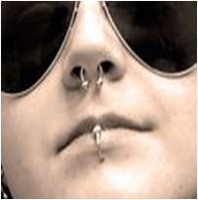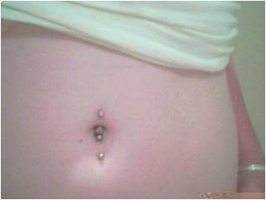|

Frank G. Shellock, Ph.D.
Adjunct Clinical Professor of Radiology and Medicine
Keck School of Medicine, University of Southern California
Adjunct Professor of Clinical Physical Therapy
Division of Biokinesiology and Physical Therapy
School of Dentistry, University of Southern California
Director for MRI Studies of Biomimetic MicroElectronic
Systems
National Science Foundation, Engineering Research Center
University of Southern California
Institute for Magnetic Resonance Safety, Education, and
Research
www.MRIsafety.com
www.IMRSER.org
www.MRIsafetybook.com
|
|
Ritual or
decorative body piercing is extremely popular as a form of
self-expression. Different types of materials are used to
make body piercing jewelry including ferromagnetic and
nonferromagnetic metals, as well as non-metallic materials.
The presence of body piercing jewelry that is made from
ferromagnetic or conductive material of a certain shape may
present a problem for a patient referred for a magnetic
resonance imaging (MRI) procedure or an individual in the MR
environment.
Risks include uncomfortable
sensations from movement or displacement that may be
mild-to-moderate depending on the site of the body piercing
and the ferromagnetic qualities of the jewelry (e.g., mass,
degree of magnetic susceptibility, etc.). In extreme cases,
serious injuries may occur. In addition, for body piercing
jewelry made from electrically conducting material, there is
a possibility of MRI-related heating that could cause
excessive temperature increases and burns.
Because of potential safety
issues, metallic body piercing jewelry should be removed
prior to entering the MR environment. However, patients or
individuals with body piercings are often reluctant to
remove their jewelry. Therefore, if it is not possible to
remove metallic body piercing jewelry, the patient or
individual should be informed regarding the potential risks.
In addition, if the body piercing jewelry is made from
ferromagnetic material, some means of stabilization (e.g.,
application of adhesive tape or bandage) should be used to
prevent movement or displacement.
To avoid potential heating of
body piercing jewelry made from conductive materials, the
use of gauze, tape, or other similar material should be used
to wrap the jewelry in such a manner as to insulate it
(i.e., prevent contact) from the underlying skin is
recommended. The patient should be instructed to immediately
inform the MR system operator if any heating or other
unusual sensation occurs in association with the body
piercing jewelry.
|



